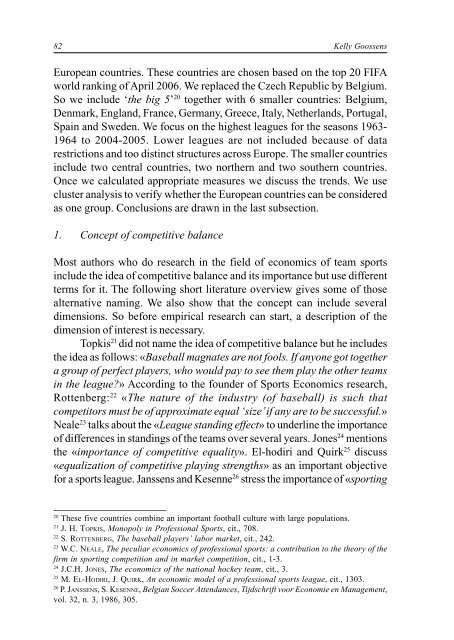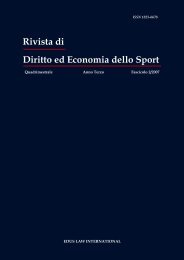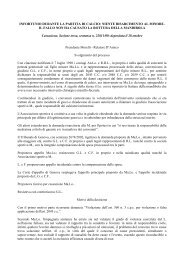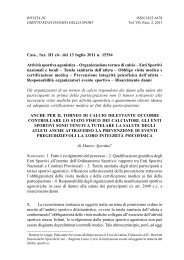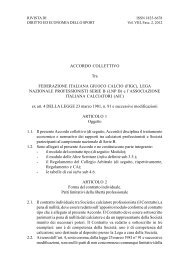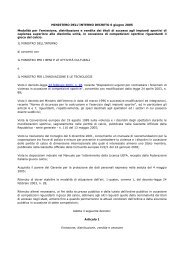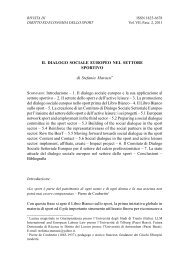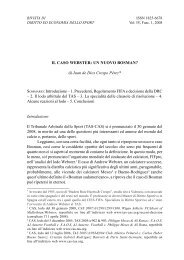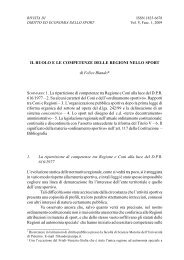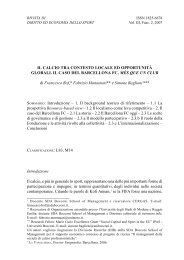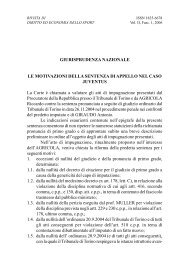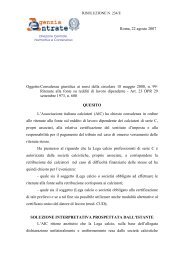82 Kelly GoossensEuropean countries. These countries are chosen bas<strong>ed</strong> on the top 20 FIFAworld ranking of April 2006. We replac<strong>ed</strong> the Czech Republic by Belgium.So we include ‘the big 5’ 20 together w<strong>it</strong>h 6 smaller countries: Belgium,Denmark, England, France, Germany, Greece, Italy, Netherlands, Portugal,Spain and Sw<strong>ed</strong>en. We focus on the highest leagues for the seasons 1963-1964 to 2004-2005. Lower leagues are not includ<strong>ed</strong> because of datarestrictions and too <strong>di</strong>stinct structures across Europe. The smaller countriesinclude two central countries, two northern and two southern countries.Once we calculat<strong>ed</strong> appropriate measures we <strong>di</strong>scuss the trends. We usecluster analysis to verify whether the European countries can be consider<strong>ed</strong>as one group. Conclusions are drawn in the last subsection.1. Concept of compet<strong>it</strong>ive balanceMost authors who do research in the field of economics of team sportsinclude the idea of compet<strong>it</strong>ive balance and <strong>it</strong>s importance but use <strong>di</strong>fferentterms for <strong>it</strong>. The following short l<strong>it</strong>erature overview gives some of thosealternative naming. We also show that the concept can include several<strong>di</strong>mensions. So before empirical research can start, a description of the<strong>di</strong>mension of interest is necessary.Topkis 21 <strong>di</strong>d not name the idea of compet<strong>it</strong>ive balance but he includesthe idea as follows: «Baseball magnates are not fools. If anyone got togethera group of perfect players, who would pay to see them play the other teamsin the league?» Accor<strong>di</strong>ng to the founder of <strong>Sport</strong>s Economics research,Rottenberg: 22 «The nature of the industry (of baseball) is such thatcompet<strong>it</strong>ors must be of approximate equal ‘size’ if any are to be successful.»Neale 23 talks about the «League stan<strong>di</strong>ng effect» to underline the importanceof <strong>di</strong>fferences in stan<strong>di</strong>ngs of the teams over several years. Jones 24 mentionsthe «importance of compet<strong>it</strong>ive equal<strong>it</strong>y». El-ho<strong>di</strong>ri and Quirk 25 <strong>di</strong>scuss«equalization of compet<strong>it</strong>ive playing strengths» as an important objectivefor a sports league. Janssens and Kesenne 26 stress the importance of «sporting____________________20These five countries combine an important football culture w<strong>it</strong>h large populations.21J. H. TOPKIS, Monopoly in Professional <strong>Sport</strong>s, c<strong>it</strong>., 708.22S. ROTTENBERG, The baseball players’ labor market, c<strong>it</strong>., 242.23W.C. NEALE, The peculiar economics of professional sports: a contribution to the theory of thefirm in sporting compet<strong>it</strong>ion and in market compet<strong>it</strong>ion, c<strong>it</strong>., 1-3.24J.C.H. JONES, The economics of the national hockey team, c<strong>it</strong>., 3.25M. EL-HODIRI, J. QUIRK, An economic model of a professional sports league, c<strong>it</strong>., 1303.26P. JANSSENS, S. KESENNE, Belgian Soccer Attendances, Tijdschrift voor Economie en Management,vol. 32, n. 3, 1986, 305.
Compet<strong>it</strong>ive balance in European football 83equal<strong>it</strong>y». Quirk and Fort and others 27 include «uncertainty of outcome» intheir research. «Symmetry among teams» is us<strong>ed</strong> by Palomino and Rigotti. 28Sloane 29 stresses the multi<strong>di</strong>mensional<strong>it</strong>y of compet<strong>it</strong>ive balance by<strong>di</strong>stinguishing short-run uncertainty 30 from long-run uncertainty of outcome. 31He adds that long run domination of one or two clubs may be more important.Four <strong>di</strong>fferent interpretations of uncertainty of outcome are given by Cairns,Jennett and Sloane in 1986. First they mention match uncertainty. The secondand third interpretations are less clear: they <strong>di</strong>stinguish between seasonaluncertainty w<strong>it</strong>h an uncertain winner that influences util<strong>it</strong>y and seasonaluncertainty w<strong>it</strong>h the probabil<strong>it</strong>y that the own team wins the championshipthat influences util<strong>it</strong>y. Last there is the absence of long-run domination. 32Vrooman 33 points out that there are actually three possible interpretations ofcompet<strong>it</strong>ive balance, all connect<strong>ed</strong> to each other but now the last is somewhatless clear for us. First there is the interpretation of closeness of leaguecompet<strong>it</strong>ion w<strong>it</strong>hin seasons. Secondly the absence of dominance of a largemarket club can be in<strong>di</strong>cat<strong>ed</strong>. Last compet<strong>it</strong>ive balance can also meancontinu<strong>it</strong>y of performance from season to season. The latter is emphasize<strong>di</strong>n his paper of 1996. Szymanski 34 provides the clearest <strong>di</strong>vision. Heemphasizes that there are three kinds of uncertainty. First there can be matchuncertainty. Secondly there is season uncertainty which looks at theuncertainty w<strong>it</strong>hin one season. The third kind is the dominance of a fewteams over seasons call<strong>ed</strong> championship uncertainty.____________________27J. QUIRK, R. D. FORT, Compet<strong>it</strong>ive Balance in <strong>Sport</strong>s Leagues, in J. Quirk, R.D. Fort, (<strong>ed</strong>.), PayDirt, The business of professional team sports, New Jersey, Princeton Univers<strong>it</strong>y Press, 1997,240-293. See also for example S. KESENNE, The salary cap proposal of the G-14 in Europeanfootball, Eur. Sp. Man. Quart., vol. 3, n. 2, 2003, 120-128; M. BAIMBRIDGE, S. CAMERON, P. DAWSON,Satell<strong>it</strong>e Television and the Demand for Football, A whole new ball game?, Scot. J. of Pol. Ec.,vol. 43, n. 3, 1996, 317-333; G. KNOWLES, K. SHERONY, M. HAUPERT, The Demand for MLB, A testof the UOO hypothesis, Am. Ec., vol. 36, n. 2, 1992, 72-80.28F. PALOMINO, L. RIGOTTI, The <strong>Sport</strong> League’s Dilemma, Compet<strong>it</strong>ive balance versus incentivesto win, Industrial Organization 0012003, Economics Working Paper Archive at WUSTL, 2001.29P. J. SLOANE, The Economics of Professional Football, The football club as a util<strong>it</strong>y maximizer,Scot. J. of Pol. Ec., vol. 18, n. 2, 1971, 121-146.30This is what Rottenberg <strong>di</strong>scusses in his paper on the labour market of baseball. The focus lieson the balance w<strong>it</strong>hin one season, so whether a team obviously outperform the others.31Long run domination looks at whether there are some teams that remain in the top over severalseasons. For example, the New York Yankees dominat<strong>ed</strong> baseball in the 1950’s when they woneight American league pennants in 8 years.32For more details we refer to their article: J. CAIRNS, N. JENNETT, P. J. SLOANE, The Economics ofProfessional Team <strong>Sport</strong>s, A survey of theory and evidence, J. of Ec. Stud., vol. 13, n. 1, 1986, 1-80.33J. VROOMAN, The Baseball Players’ Labour Market Reconsider<strong>ed</strong>, South. Ec. J., vol. 63, n. 2,1996, 339-360.34S. SZYMANSKI, Economic design of sporting contests, c<strong>it</strong>..


